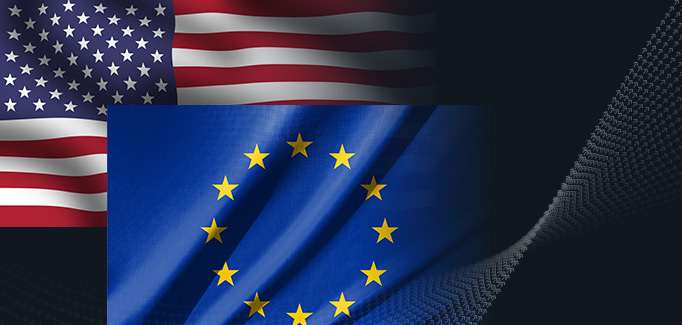The Basics of Fighting Money Laundering
September 24th, 2021

In a world where using digital banking channels becomes easier and more accessible than ever before, the risk of bad actors taking advantage of these changes and laundering money into the economy greatly increases. Due to this ever-looming threat, the global community continuously implements regulations and anti-money laundering (AML) best practices to protect against money laundering threats. AML consists of all the policies, laws and regulations put in place to prevent financial crime.
Regulatory bodies around the globe are continually monitoring and assessing new and evolving financial crime threats. To ensure these threats are correctly managed, regulations and legislation is always being updated. Any financial services organization (FSO) must comply with these AML regulations to operate within the industry, which is why FSOs employ compliance departments to ensure that AML compliance is always reached.
As covered in our blog on how money laundering works, money laundering is the “cleaning” of illegally acquired funds to introduce back into the economy for legitimate business operations without needing to stress about the cleaned funds being linked back to the crimes from which it originated.
There are three stages to money laundering:
- Placement – The first stage pertains to placing unlawfully obtained funds into FSOs via banks, casinos, storefronts, or other similar businesses. Whether it’s by breaking up large amounts into smaller payments to avoid suspicion, or buying high-valued goods that can be resold for legitimate payment, the criminal underworld has no shortage of tools at their disposal to funnel money.
- Layering – Often considered the most complex and important facet of money laundering, layering involves gradually adding legitimacy to funds, via complex financial transactions, to hide the origin of criminal activity and confuse AML checks.
- Integration – The final stage of the money laundering process finds newly legitimized funds reintroduced into the economy, giving the appearance of belonging to legitimate sources. At this stage, it becomes extremely difficult for AML checks to distinguish between legitimate money and “cleaned” dirty money, allowing criminals to now invest and profit with the funds.
When all of these stages are successfully performed, criminals are able to disrupt the global GDP and create a system of laundered money to extend their various business operations.
How did the Practice of AML Come to Be?
As advanced as the progress we’ve made in anti-money laundering is over the years, regulating money laundering wasn’t always seen as a priority. In fact, the first piece of legislation wasn’t introduced until 1970. This legislation, the Bank Secrecy Act (BSA) of 1970, was passed in the United States, marking the country as one of the first nations to take steps in combating all forms of money laundering. Since its passing into law, the BSA has only been amended and strengthened with additional money laundering regulations to keep pace with the advancing technologies financial criminals employ.
Now, the Financial Crimes Enforcement Network (FinCEN) is the designated arbitrator of the BSA, carrying out its mission to “safeguard the financial system from the abuses of financial crime, including terrorist financing, money laundering and other illicit activity.”
The rest of the world was soon to follow in the United States’ footsteps, most notably in Paris in 1989, where multiple countries and organizations formed the global Financial Action Task Force (FATF). Initially, FATF’s mission was to examine and develop anti-money laundering measures, establish international standards to prevent money laundering and promote their implementation in FSOs. However, the scope of FATF was expanded greatly after the 9/11 terrorist attacks to include combating terrorist financing as well.
Other notable advances in the AML effort include the International Monetary Fund (IMF), which provides its 189 members with regulations to comply with international standards, and the European Union Directives. First brought on by the European Union in 1990, directives are constantly revised to reduce the risks associated with money laundering and terrorist financing.
How Vital is Proper AML Processes for the Health of the Global Economy?
At first glance, one would only consider money laundering virtually a victimless crime, where the funds funneled back into the economy would only help to get that money back into the hands of law-abiding citizens. However, when breaking down the parties and structures affected by money laundering, one can easily see that there is nothing “victimless” about it.
Major areas and structures that money laundering affects is as follows:
- Money demand – More common in countries where there are no regulations on laundering, the process is easy for financial criminals. However, due to the budget deficit and high inflation brought on by money laundering, the global market’s stability is affected, and the ability to predict demands for money becomes increasingly difficult.
- Growth rates – When a country suffers from financial instability, the companies based in these countries will rely upon foreign investors to help with growth. However, as these foreign investors review the risk of investing in a certain country as much as investing in a company, they might deem the investment too risky, leading to long-term sustainable growth decline.
- Income distribution – The increasing enrichment of specific individuals by money laundering has critical consequences for the distribution of income. This income gap between individuals leads to an increase in crime, as well as puts more tax burden on the private sector in an effort to counteract the strain of money laundering.
- Tax revenues – Illegally acquired funds don’t contribute to revenue obtained by taxes, leading to budget deficits in public expenditures. Countries that experience low tax revenue turn to borrowing or emissions policy, both negatively affecting the economy.
- Enabling crime and terrorist activity – Lastly, when financial crime goes unpunished, it encourages an increase of money laundering among more bad actors. This increase leads to criminal empires expanding their operations with more funds, as well as increased funding for terrorist cells around the world.
Money laundering has far reaching consequences, and it’s up to FSOs to help enact the guidelines and regulations set by international bodies to protect the health of both local and global economies. With illicit funds making up between two to five percent of global GDP, the focus is on AML units to fully prevent money laundering more than ever before.
Since funneling illegal money through legitimate financial channels is the last major step criminals need to complete before the money is “cleaned,” these FSOs face the risk of increased audit and brand damage if it’s discovered that their organization’s lack of protection led to mass amounts of money laundering. In 2018 alone, the total value of AML fines faced by FSOs was $4.27 billion, and 2019 saw those penalties double in value due to primarily banks not fully complying to regulations.
To ensure compliance, organizations should look to an AML compliance officer. This officer follows the regulations as they are updated, monitoring their companies’ activities as it relates to these regulations. Additionally, the officer must also keep track of various sanctions and watchlists, monitoring the ever-changing risk levels associated with companies and countries.
Knowing Your Customer: The Crux Behind Preventing a Majority of Financial Crime
The best first step an FSO can take in improving their AML practices and limiting penalties by AML regulation bodies is to strengthen their Know Your Customer (KYC) program. Put simply, KYC refers to the steps an FSO needs to take when onboarding a new relationship with an individual or entity by building out a risk profile. When this risk profile is properly built, FSOs can stop money laundering from occurring within their organization before the bad actors can even infiltrate.
While KYC is a vital part of any AML process, it’s only one facet. AML as a whole covers the entire customer lifecycle and requires all FSOs to monitor and understand their customers and their risks end-to-end, across their entire lifecycle. Only with this awareness can an FSO perform effective detection of suspicious behavior and ultimately make a difference in the fight against money laundering.
Money laundering casts a long shadow over the global community and how the world conducts business. If left unchecked, laundering efforts could cripple economies at all levels. It’s ultimately up to FSOs to follow the policies and regulations laid out to stop money laundering before it has a chance to work its way into the global economy.
Complying with AML regulations doesn’t just mean avoiding penalties. By protecting the global community against money laundering, FSOs can keep economies stable, allowing them to grow and prosper. When the primary apparatus that criminals and terrorist cells use to fund their operations is disrupted, the world at large becomes a safer place. Strengthening AML protections against financial criminals is a fight worth fighting.
To learn more about how FSOs can protect themselves from money laundering and complying to regulations, click here.




